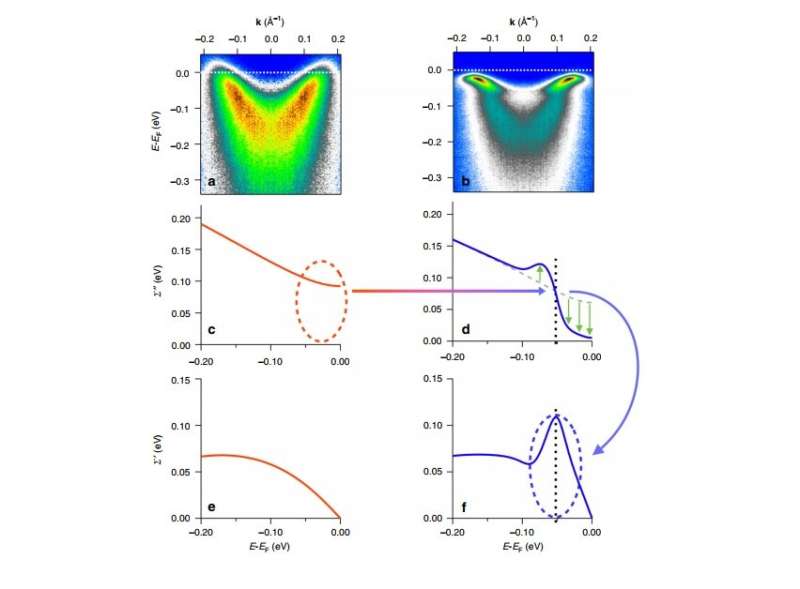January 18, 2018 feature
Physicists find clues to the origins of high-temperature superconductivity

Ever since cuprate (copper-containing) superconductors were first discovered in 1986, they have greatly puzzled researchers. Cuprate superconductors have critical superconducting temperatures—the point at which their electrical resistance drops to zero—of up to 138 K at ambient pressure, which far exceeds the critical temperatures of other superconductors and is even higher than what is thought possible based on theory.
Now in a new study, researchers have discovered the existence of a positive feedback loop that gratly enhances the superconductivity of cuprates and may shed light on the origins of high-temperature cuprate superconductivity—considered one of the most important open questions in physics.
The researchers, Haoxiang Li et al., at the University of Colorado at Boulder and the École Polytechnique Fédérale de Lausanne, have published a paper on their experimental ARPES (Angle Resolved Photoemission Spectroscopy) results on high-temperature cuprate superconductors in a recent issue of Nature Communications.
As the researchers explain, the positive feedback mechanism arises from the fact that the electrons in the non-superconducting cuprate state are correlated differently than in most other systems, including in conventional superconductors, which have strongly coherent electron correlations. In contrast, cuprates in their non-superconducting state have strongly incoherent "strange-metal" correlations, which are at least partly removed or weakened when the cuprates become superconducting.
Due to these incoherent electron correlations, it has been widely believed that the framework that describes conventional superconductivity—which is based on the notion of quasiparticles—cannot accurately describe cuprate superconductivity. In fact, some research has suggested that cuprate superconductors have such unusual electronic properties that even attempting to describe them with the notion of particles of any kind becomes useless.
This leads to the question of, what role, if any, do the strange-metal correlations play in high-temperature cuprate superconductivity?
The main result of the new paper is that these correlations don't simply disappear in the cuprate superconducting state, but instead get converted into coherent correlations that lead to an enhancement of the superconductive electron pairing. This process results in a positive feedback loop, in which the conversion of the incoherent strange-metal correlations into a coherent state increases the number of superconductive electron pairs, which in turn leads to more conversion, and so on.
The researchers found that, due to this positive feedback mechanism, the strength of the coherent electron correlations in the superconducting state is unprecedented, greatly exceeding what is possible for conventional superconductors. Such a strong electron interaction also opens up the possibility that cuprate superconductivity might occur due to a completely unconventional pairing mechanism—a purely electronic pairing mechanism that could arise solely due to quantum fluctuations.
"We experimentally discover that the incoherent electron correlations in the strange metal 'normal state' are converted to coherent correlations in the superconducting state that help strengthen the superconductivity, with an ensuing positive feedback loop," coauthor Dan Dessau at the University of Colorado at Boulder told Phys.org. "Such a strong positive feedback loop should strengthen most conventional pairing mechanisms but could also allow for a truly unconventional (purely electronic) pairing mechanism."
Surprisingly, the researchers also found that they could describe their experimental results using a semi-conventional quasiparticle-like approach, despite the fact that cuprate superconductors behave so differently than other materials.
In the future, the researchers plan to investigate whether this positive feedback mechanism can be integrated into other materials, perhaps leading to new kinds of high-temperature superconductors.
"We can look for similar positive feedback loops in related materials, and can also use the newly developed ARPES-based techniques to probe the details of the electronic correlations in even greater detail," Li said.
More information: Haoxiang Li et al. "Coherent organization of electronic correlations as a mechanism to enhance and stabilize high-TC cuprate superconductivity." Nature Communications. DOI: 10.1038/s41467-017-02422-2
Journal information: Nature Communications
© 2018 Phys.org




















